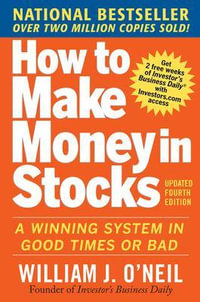
At a Glance
282 Pages
15.8 x 23.3 x 2.4
Paperback
RRP $152.00
$125.50
17%OFF
or 4 interest-free payments of $31.38 with
orAims to ship in 7 to 10 business days
When will this arrive by?
Enter delivery postcode to estimate
Commodity Derivatives: A Guide for Future Practitioners describes the origins and uses of these important markets. Commodities are often used as inputs in the production of other products, and commodity prices are notoriously volatile. Derivatives include forwards, futures, options, and swaps; all are types of contracts that allow buyers and sellers to establish the price at one time and exchange the commodity at another.
These contracts can be used to establish a price now for a purchase or sale that will occur later, or establish a price later for a purchase or sale now. This book provides detailed examples for using derivatives to manage prices by hedging, using futures, options, and swaps. It also presents strategies for using derivatives to speculate on price levels, relationships, volatility, and the passage of time. Finally, because the relationship between a commodity price and a derivative price is not constant, this book examines the impact of basis behaviour on hedging results, and shows how the basis can be bought and sold like a commodity.
The material in this book is based on the author's 30-year career in commodity derivatives, and is essential reading for students planning careers as commodity merchandisers, traders, and related industry positions. Not only does it provide them with the necessary theoretical background, it also covers the practical applications that employers expect new hires to understand. Examples are coordinated across chapters using consistent prices and formats, and industry terminology is used so students can become familiar with standard terms and concepts. This book is organized into 18 chapters, corresponding to approximately one chapter per week for courses on the semester system.
CHAPTER 2. TRADING FUTURES AND OPTIONS
Pit Trading The Trading Pit Order Types and Order Execution Open Outcry and Hand Signals Price Reporting Electronic Trading The Role of Technology Components of Electronic Trading Central Limit Order Book Matching Engine Front End Customer Protection Features Benefits vs. Costs of Electronic Trading
CHAPTER 3. UNDERSTANDING AND INTERPRETING FUTURES PRICES
How Futures Prices Are Quoted Futures Prices and Summary Price Measures Tick Size and Contract Size Commodity Codes and Month Codes Contract Expiration Long and Short Positions Measures of Trading Activity Volume and Open Interest Trading Impact on Volume and Open Interest Other Relationships between Volume and Open Interest Interpreting Price Differences: Time, Space, and Form Price Differences Due to Time: Carrying Costs Carrying Costs and Convenience Yield The Forward Curve Forward Curve for a Normal Market Forward Curve for an Inverted Market Effects of Seasonality Forward Curve for Nonstorable Commodities Price Differences Due to Space: Transportation Costs Locational Price Differentials Locational Premiums and Discounts Price Differences Due to Form: Processing Costs Input-Output and Quality Differentials Spreads: Processing, Intra-Commodity, and Inter-Commodity Combinations of Time, Space, and/or Form
CHAPTER 4. MARGINS, CLEARING, DELIVERY, AND FINAL SETTLEMENT
Margins in Futures Trading Initial Margin, Maintenance Margin, and Margin Calls The Clearing House and Clearing Firms The Clearing House as Central Counterparty The Daily Settlement Process Margin Account Example Final Settlement via Delivery The Physical Delivery Process Delivery as Arbitrage Steps in the Delivery Process Final Settlement via Cash Settlement
CHAPTER 5. MARKET REGULATION
Futures as Contracts Contract Specifications Par Quality Premiums and Discounts for Quality Variations Quantity Delivery Location Delivery Date Cash Settlement vs. Physical Delivery Position Limits Spot Limits Non-Spot Limits All-Months-Combined Limits Position Limits for Hedgers Reportable Levels Minimum Price Increment Daily Price Limits Expiration Date and Last Trading Date Regulation by Exchanges Regulation by the Federal Government Legislative History Regulation and the Perfect Competition Model Regulatory Purpose Creation of the Commodity Futures Trading Commission Authority and Jurisdiction Organization Self-Regulation by the Industry Applications in Other Sectors and Countries Appendix 5.1
CHAPTER 6. HEDGING WITH FUTURES
The Role of Correlation Hedging Against a Price Increase Loss on Cash Position, Gain on Futures Position Gain on Cash Position, Loss on Futures Position No Gain or Loss on Cash Position, No Gain or Loss on Futures Position Stabilizing the Net Purchase Price Hedging Against a Price Decrease Loss on Cash Position, Gain on Futures Position Gain on Cash Position, Loss on Futures Position No Gain or Loss on Cash Position, No Gain or Loss on Futures Position Stabilizing the Net Sale Price More on the Role of Correlation: An Example from the Corn Market Price Changes vs. Prices Levels: The Importance of Returns
CHAPTER 7. HEDGING AND THE BASIS
Hedging and Basis Changes Actual Values and Expected Values Basis Behavior and the Correlation of Returns Long Hedging and Basis Behavior Rising Prices, Positive Initial Basis, and Basis Strengthens Rising Prices, Positive Initial Basis, and Basis Weakens Rising Prices, Negative Initial Basis, and Basis Strengthens Rising Prices, Negative Initial Basis, and Basis Weakens Falling Prices, Positive Initial Basis, and Basis Strengthens Falling Prices, Positive Initial Basis, and Basis Weakens Falling Prices, Negative Initial Basis, and Basis Strengthens Falling Prices, Negative Initial Basis, and Basis Weakens Basis Impact on Long Hedging Results Short Hedging and Basis Behavior Falling Prices, Positive Initial Basis, and Basis Strengthens Falling Prices, Positive Initial Basis, and Basis Weakens Falling Prices, Negative Initial Basis, and Basis Strengthens Falling Prices, Negative Initial Basis, and Basis Weakens Rising Prices, Positive Initial Basis, and Basis Strengthens Rising Prices, Positive Initial Basis, and Basis Weakens Rising Prices, Negative Initial Basis, and Basis Strengthens Rising Prices, Negative Initial Basis, and Basis Weakens Basis Impact on Short Hedging Results
CHAPTER 8. HEDGING ENHANCEMENTS
Types of Hedges Anticipatory Hedge Inventory Hedge Rolling a Hedge Reasons for Rolling a Hedge Rolling Forward a Long Hedge Rolling Back a Short Hedge Limits on Rolling Forward or Rolling Back Cross-Hedging Why Cross-Hedging is Necessary Cross-Hedging Grain Sorghum Using Corn Futures Regression Equation Hedge Ratio Converting the Hedge Ratio into Futures Contracts Hedging Effectiveness Using Price Changes vs. Price Levels in Regressions
CHAPTER 9. PROFIT MARGIN HEDGING AND INVERSE HEDGING
Profit Margin Hedging Soybean Crush Margin Crude Oil Refining Margin Cattle Feeding Margin Other Processing Spreads Inverse Hedging Long Inverse Hedge with a Short Forward Contract Using Long Futures to Offset a Short Forward Drawbacks of a Long Inverse Hedge Short Inverse Hedge with a Long Forward Contract Using Short Futures to Offset a Long Forward Drawbacks of a Short Inverse Hedge
CHAPTER 10. HEDGING AND BASIS TRADING
Redefining the Basis and the Cash Price Basis as a Tangible Value Defining the Impact of Basis Changes Commercial Hedging Short Hedging - Buying the Basis Long Hedging - Selling the Basis
CHAPTER 11. BASIS TRADING AND ROLLING A HEDGE
Rolling a Hedge to Capture a Favorable Basis Rolling Forward a Long Hedge Spread-Adjusted Futures Prices Spread-Adjusted Basis Values Rolling Back a Short Hedge Spread-Adjusted Futures Prices Spread-Adjusted Basis Values Spreads, the Forward Curve, and Basis Behavior Spread Impact on Hedging Results Basis Impact of an Implicit Bear Spread Basis Impact of an Implicit Bull Spread
CHAPTER 12. SPECULATION IN FUTURES
Speculation vs. Investment Speculative Styles Scalping Position Trading Spreading Intra-Market Spreads Inter-Market Spreads Speculators and Speculative Impact Commitments of Traders Open Interest as the Measure of Commitment Reportable Traders by Specific Occupation or Activity Producer/Merchant/Processor/User Swap Dealers Managed Money Other Reportables Total Reportable Positions Nonreportable Positions Percent of Open Interest Held by Largest Traders Speculative Participation in Commodity Futures Speculative Vehicles Returns to Speculation
CHAPTER 13. INTRODUCTION TO OPTIONS ON FUTURES
How Options Work An Example from Real Estate Options on Futures Option Buyers and Sellers Exercise or Abandon In the Money vs. Out of the Money Intrinsic Value of an Option Similarities between Options and Insurance Option Trading Time Value of an Option Time Value Decay Exercise and Assignment Potential Gains and Losses, Margins and Margin Calls Automatic Exercise Option Expiration Date and Futures Delivery Trading Venue and Method Clearing and Settlement Market Regulation Options on Actuals
CHAPTER 14. OPTION PRICING
The Black Model Call Option Formula Call Option Pricing Example Put Option Formula Put Option Pricing Example Measuring Volatility Model Assumptions and Shortcomings Put-Call Parity Pricing with Put-Call Parity Identifying and Arbitraging Price Discrepancies Option Sensitivity and the Greeks Properties of Delta and Trading Applications Properties of Gamma Properties of Theta Properties of Rho Properties of Vega Summary
CHAPTER 15. PROFIT TABLES AND PROFIT DIAGRAMS
Futures and Cash Positions: Linear Profits Long Futures Short Futures Long Cash Hedging Long Cash with Short Futures Options Positions: Nonlinear Profits Long Calls Short Calls Long Puts Short Puts Hedging Long Cash with Long Puts Short Hedging with Long Puts vs. Short Futures Hedging Long Cash with Short Calls Short Hedging with Short Calls vs. Short Futures Hedging Short Cash with Long Futures Hedging Short Cash with Long Calls Long Hedging with Long Calls vs. Long Futures Hedging Short Cash with Short Puts Long Hedging with Short Puts vs. Long Futures Discussion
CHAPTER 16. HEDGING WITH OPTIONS
Option-Based Hedging Strategies Floor Ceiling Collar Zero-Cost Collar Inverse Collar Covered Call and Covered Put Delta-Neutral Hedging Impact of Changing Intrinsic Value and Time Value Profit Diagrams Prior to Expiration Dynamic Hedging ExampleDiscussion Delta Hedging by Option Market Makers Synthetic Futures and Options Synthetic Options Synthetic Futures Profit Diagram for Synthetic Long Futures Profit Diagram for Synthetic Short Futures Other Uses for Synthetic Positions
CHAPTER 17. SPECULATING WITH OPTIONS
Intrinsic Value Strategies Time Value Strategies Volatility Strategies Straddle Strangle Other Volatility Strategies Spread Strategies Conversion and Reversal Box Spread Bull Spreads and Bear Spreads Bull Call Spread Bear Call Spread Bull Put Spread Bear Put Spread Identical Results from Bull and Bear Spreads Box Spread using Bull and Bear Spreads
CHAPTER 18. COMMODITY SWAPS
Swaps and Forwards Swap Features and Applications Fixed and Floating, Long and Short Commodity Swap Example First Settlement Results Second Settlement Results Subsequent Settlements Swap Contract Specifications Flexibility vs. Liquidity The Market for Commodity Swaps Index
ISBN: 9780765645371
ISBN-10: 0765645378
Published: 13th April 2018
Format: Paperback
Language: English
Number of Pages: 282
Audience: College, Tertiary and University
Publisher: Taylor & Francis Ltd
Country of Publication: GB
Dimensions (cm): 15.8 x 23.3 x 2.4
Weight (kg): 0.4
Shipping
| Standard Shipping | Express Shipping | |
|---|---|---|
| Metro postcodes: | $9.99 | $14.95 |
| Regional postcodes: | $9.99 | $14.95 |
| Rural postcodes: | $9.99 | $14.95 |
How to return your order
At Booktopia, we offer hassle-free returns in accordance with our returns policy. If you wish to return an item, please get in touch with Booktopia Customer Care.
Additional postage charges may be applicable.
Defective items
If there is a problem with any of the items received for your order then the Booktopia Customer Care team is ready to assist you.
For more info please visit our Help Centre.
You Can Find This Book In

Blue Ocean Strategy, Expanded Edition
How to Create Uncontested Market Space and Make the Competition Irrelevant
Hardcover
RRP $54.99
$38.35
OFF
This product is categorised by
- Non-FictionEconomicsEconomics of Industrial Organisation
- Non-FictionIndustry & Industrial StudiesPrimary IndustriesAgriculture & Related Industries
- Non-FictionReference, Information & Interdisciplinary SubjectsInterdisciplinary StudiesDevelopment Studies
- Non-FictionEngineering & TechnologyAgriculture & FarmingAgricultural Science
- Non-FictionAccounting & FinanceFinanceInvestment & SecuritiesCommodities & Trading
- Text BooksHigher Education & Vocational TextbooksAccounting, Business & Finance Higher Education Textbooks






















